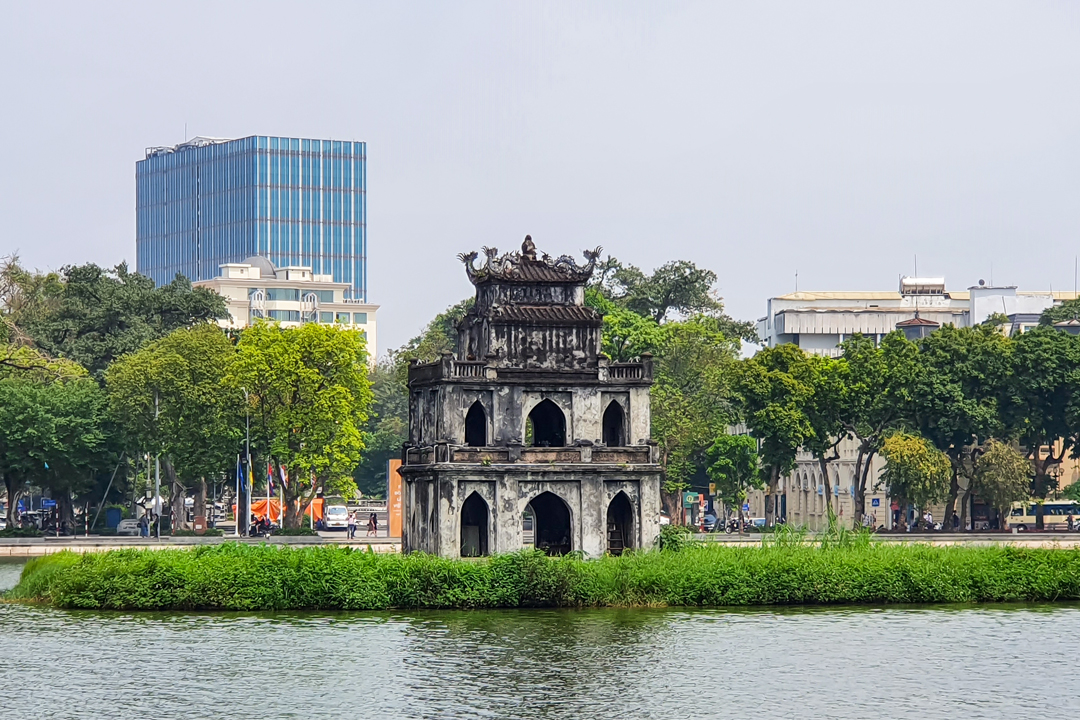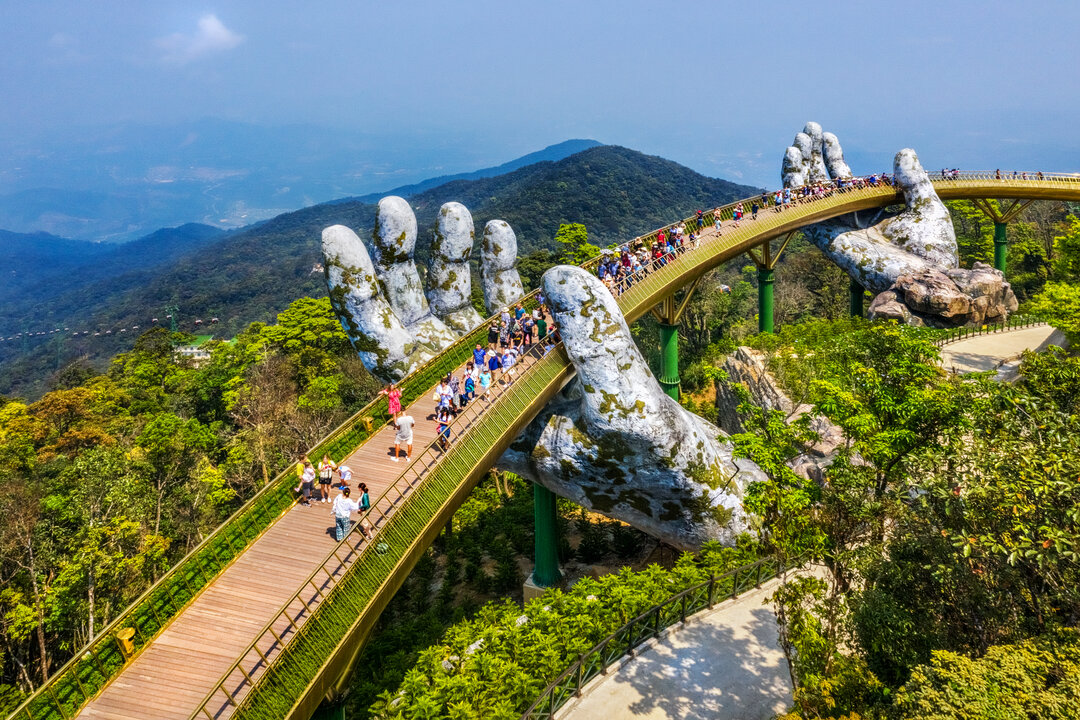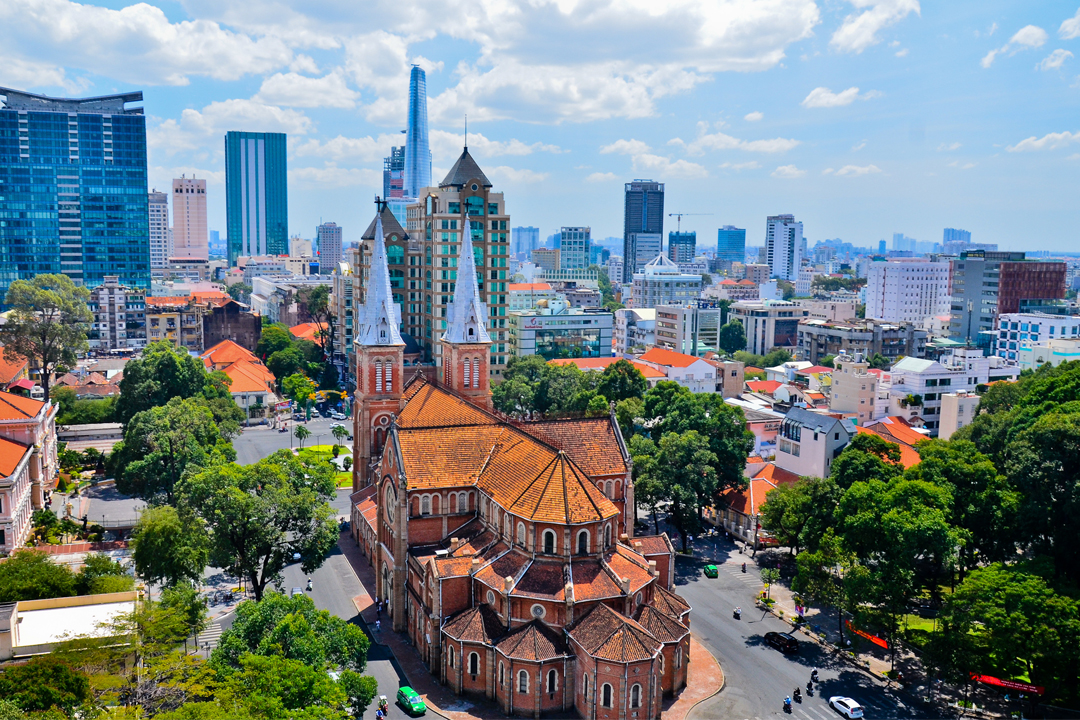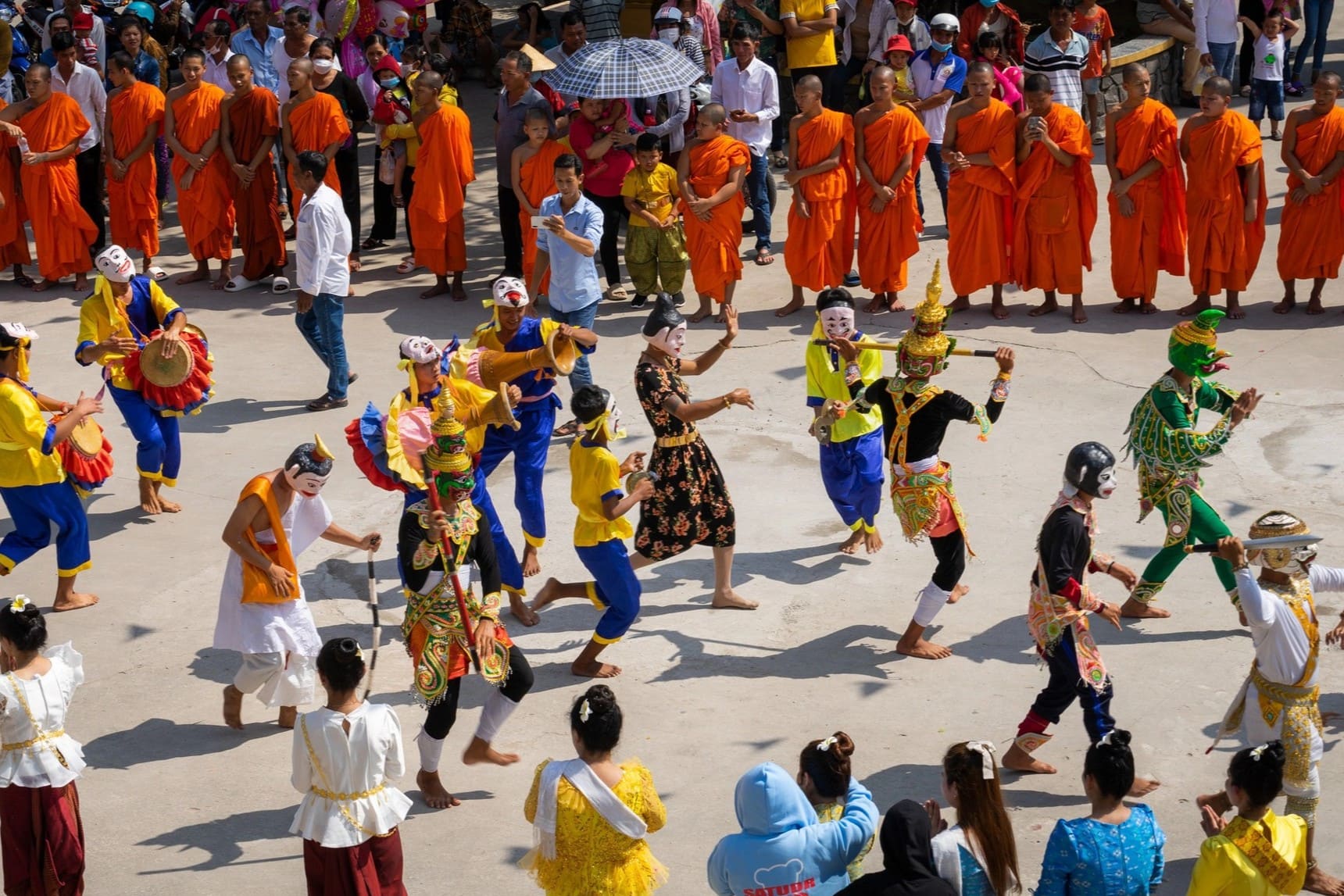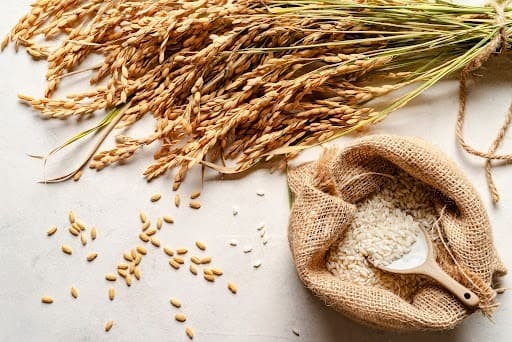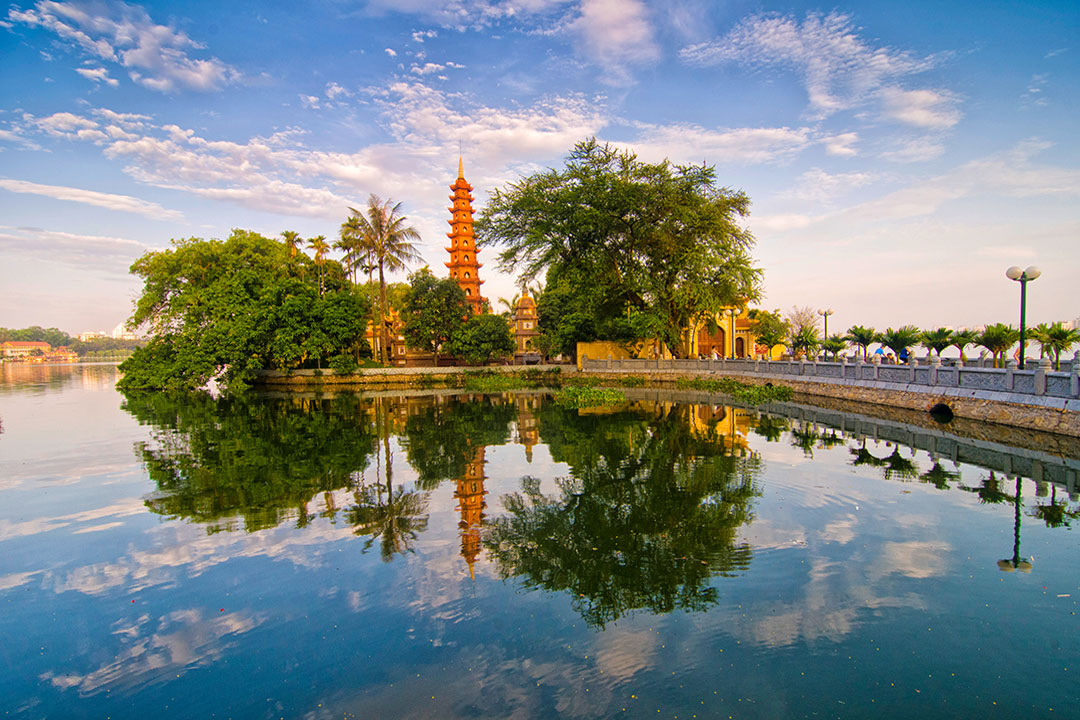Tran Quoc Pagoda: History, Architecture, Significance & Travel Guide
Nestled on the tranquil shores of West Lake, Tran Quoc Pagoda is the oldest Buddhist temple in Hanoi, with a history spanning over 1,500 years. Built in the 6th century under Emperor Ly Nam De, this sacred site reflects Vietnam’s Buddhist evolution while preserving its spiritual and architectural grandeur. Its striking red stupa, intricate carvings, and serene courtyards make it a breathtaking sight, drawing both devotees and travelers seeking a moment of peace amidst Hanoi’s bustling streets.
Beyond its historical significance, Tran Quoc Pagoda embodies a unique fusion of Vietnamese and Indian Buddhist influences. The towering stupa, adorned with lotus-shaped motifs, symbolizes enlightenment, while the carefully preserved statues and altars reflect centuries of devotion. The pagoda’s location on a small islet, connected to the mainland by a graceful bridge, enhances its sense of tranquility, making it a perfect retreat to experience the spiritual heart of Hanoi.
A visit to Tran Quoc Pagoda is more than just an architectural or cultural excursion - it’s an immersive journey into Vietnam’s deep-rooted Buddhist traditions. The pagoda offers an enriching experience that lingers long after you leave. In this guide of GTrip, you’ll uncover the stories, artistry, and spiritual essence that make Tran Quoc Pagoda a timeless symbol of Hanoi’s cultural heritage.
Overview of Tran Quoc Pagoda
Location: No. 46 Thanh Nien Street, Tay Ho Ward (No. 46 Thanh Nien Street, Yen Phu Ward, Tay Ho District, Hanoi)
Tran Quoc Pagoda stands as a testament to the nation's rich religious and cultural heritage. Its history spans over 1,500 years, marked by significant transformations that reflect Vietnam's evolving dynastic eras and the enduring significance of Buddhism.
Tran Quoc Pagoda is one of the famous pagodas in Hanoi. If you have the opportunity to experience Hanoi tours, you should visit the pagoda once to better appreciate the history and architecture of this site.
History of Tran Quoc Pagoda
To understand its long journey, let’s start with the origins before moving through the key dynastic changes.
Origins and foundation in the 6th century
Established during the reign of Emperor Ly Nam De (544 - 548), Tran Quoc Pagoda holds the distinction of being Hanoi's oldest Buddhist temple. Originally named "Khai Quoc", meaning "National Founding", the pagoda was situated on the banks of the Red River, symbolizing its role in spreading Buddhism. The choice of location underscored the early Vietnamese emphasis on harmony with nature, a principle deeply ingrained in the nation's architectural philosophies.
Historical transformations through the dynasties
Throughout its extensive history, Tran Quoc Pagoda has undergone several relocations and renovations, each reflecting the cultural and political shifts of successive Vietnamese dynasties.
- 15th Century: During the reign of King Le Thai Tong from 1434 to 1442, the pagoda was renamed "An Quoc", translating to "Pacification of the Realm", reflecting the era's aspirations for national peace and stability.
- 1615 Relocation: Due to the encroachment of the Red River, the pagoda was moved to its current location on Kim Ngu (Golden Fish) Islet within West Lake. This relocation was necessitated by the unstable riverbanks threatening the original structure.
- 17th Century renaming: During the reign of King Le Hy Tong (1681 - 1705), the pagoda was bestowed the name "Tran Quoc", meaning "Protecting the Nation". This signifies its continued importance as a spiritual bastion for the country.
- 1815 Renovation: Under the Nguyen Dynasty, significant restorations were undertaken, including the renovation of the main sanctuary, reception hall, and other structures.
These transformations preserved the structural integrity of Tran Quoc Pagoda and also reinforced its role as a spiritual and cultural landmark through Vietnam's dynastic changes.
Tran Quoc Pagoda in modern times
In contemporary times, Tran Quoc Pagoda continues to serve as a vibrant symbol of Hanoi's historical and cultural fabric. While remaining an active place of worship, it has also become a significant cultural and tourist attraction. The pagoda's picturesque setting on West Lake, combined with its rich history and architectural beauty, draws both locals and international tourists seeking spiritual solace and cultural insight.
Preservation efforts have been concentrated on maintaining the pagoda's historical integrity while accommodating the growing number of tourists. These initiatives ensure that Tran Quoc Pagoda remains not merely a relic of the past but a living cultural monument that continues to influence perceptions of Vietnamese Buddhist heritage.
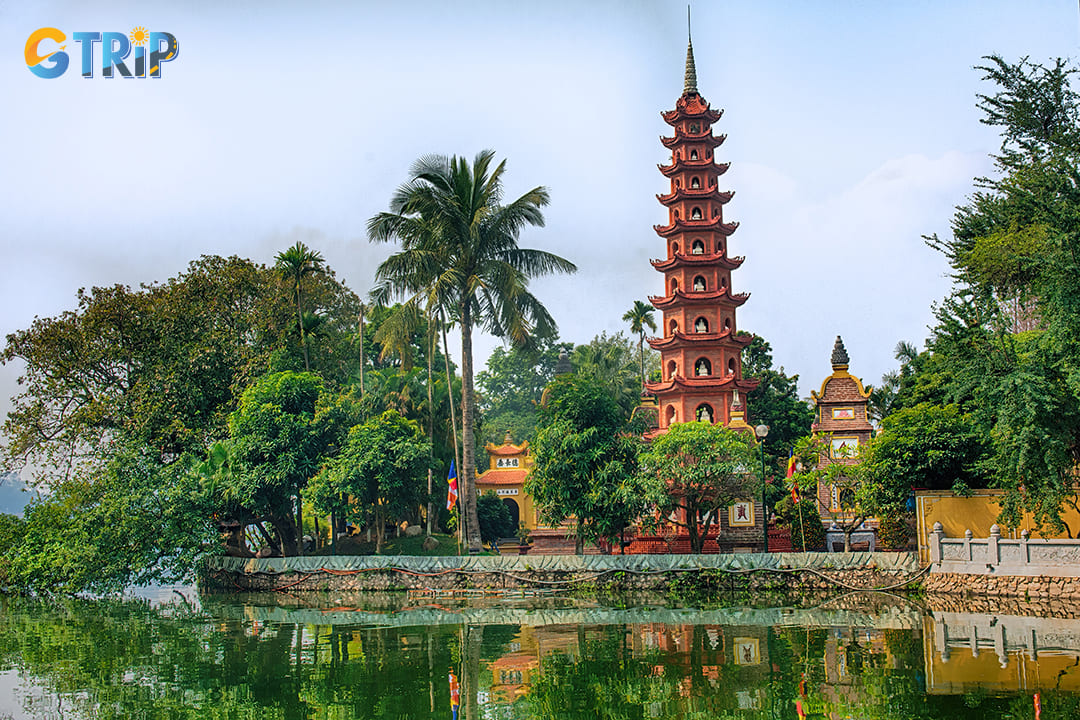
Tran Quoc Pagoda stands as a testament to the nation's rich religious and cultural heritage
Architectural marvels of Tran Quoc Pagoda
Tran Quoc Pagoda stands as an architectural testament to Vietnam's rich cultural and religious history. This ancient Buddhist temple captivates with its serene location by West Lake and with its intricate design that embodies both spiritual symbolism and historical significance. Each architectural element tells a story, woven into the tapestry of Vietnam's cultural heritage.
Distinctive features and design elements
The architectural framework of Tran Quoc Pagoda is a harmonious blend of both simplicity and grandeur. Constructed in the shape of a blooming lotus, it signifies purity and enlightenment, which are core tenets of Buddhism. This design choice is not arbitrary but a deliberate embodiment of religious philosophy through architecture.
One of the most striking features is the multiple-storey lotus tower, which, at its peak, houses a precious relic believed to be a part of the Buddha himself. This tower, intricately carved and adorned, serves not just as a focal point for worshippers but also as a beacon of spiritual aspiration for passersby. Surrounding the main tower are smaller structures and stupas, each built with purpose and precision, interacting with the natural landscape to create a space conducive to contemplation.
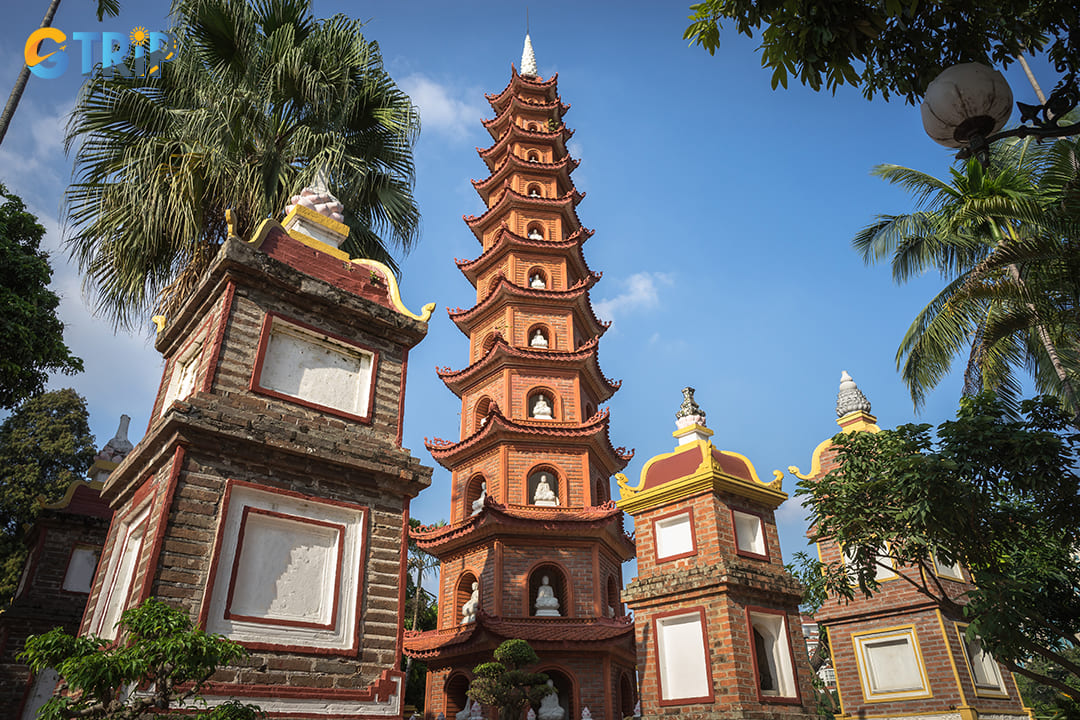
One of the most striking features is the multiple-storey lotus tower, which, at its peak, houses a precious relic believed to be a part of the Buddha himself
Chinese influences and Buddhist symbolism
The influence of Chinese architecture is evident in the pagoda's intricate carvings and the use of traditional motifs such as dragons and phoenixes, which symbolize power and prosperity. These elements demonstrate the historical exchanges and cultural integration between Vietnam and its neighboring regions.
Buddhist symbolism is omnipresent, from the lotus petals surrounding the base of the main stupa to the bodhi tree found within the complex. The bodhi tree is not just an ornamental fixture but a living symbol of the sacred tree under which the Buddha attained enlightenment. This integration of natural and built elements highlights the balance sought in Buddhist teachings between human endeavors and nature.
Restoration efforts and preservation
Preserving Tran Quoc Pagoda has been a priority for historians and conservationists, recognizing its value as a cultural and spiritual edifice. Over the centuries, it has undergone several restoration efforts, particularly after natural disasters and the French colonial period which threatened its structural integrity. These efforts have sought to maintain the original design while reinforcing the structure to withstand time and nature's tests.
During the 19th century, significant restorations were undertaken to maintain the pagoda in its authentic glory. Modern techniques combined with traditional craftsmanship ensure that the pagoda continues to provide spiritual sustenance while standing proud as a relic of historical and cultural significance. The temple's longevity is a testament to the meticulous care and devotion invested in its preservation.
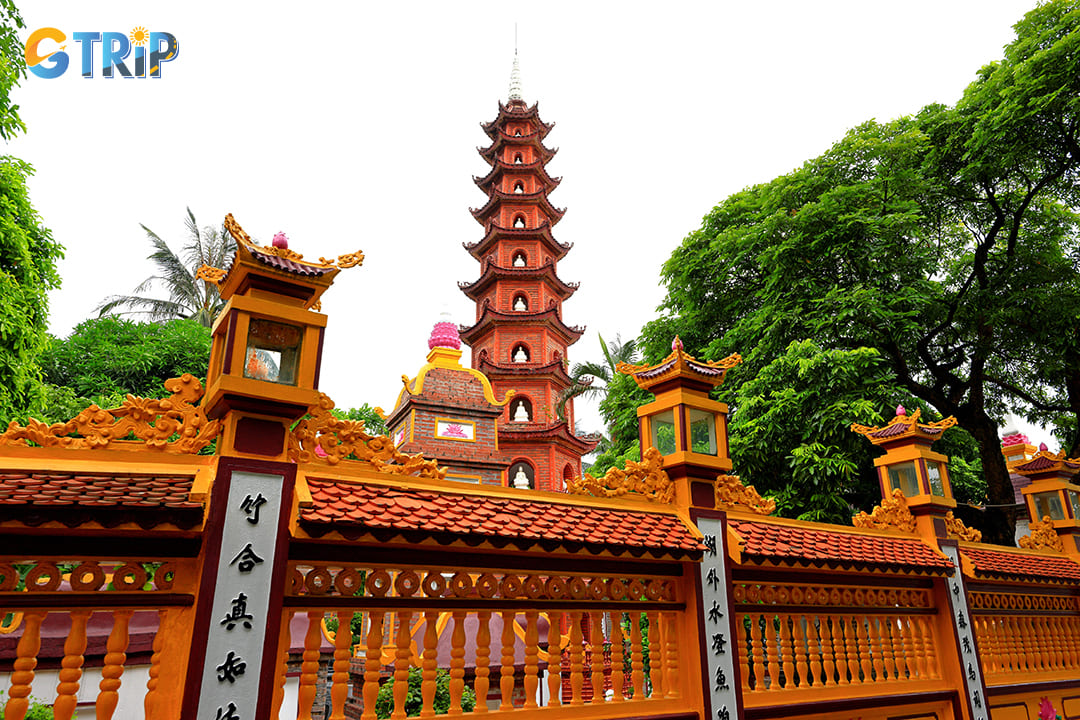
The influence of Chinese architecture is evident in the pagoda's intricate carvings and the use of traditional motifs such as dragons and phoenixes
Religious & cultural importance
Tran Quoc Pagoda stands as a bastion of religious reverence and cultural richness, reflecting the deep-seated traditions and spiritual fabric of Vietnam. Its significance is woven through layers of history, religion, and the everyday lives of local believers. The pagoda is a physical space of worship and also is intrinsically tied to the cultural identity of Hanoi and the broader narrative of Vietnamese Buddhism.
Role in Vietnamese Buddhism
Tran Quoc Pagoda is central to the practice and propagation of Buddhism in Vietnam. Acting as both a monastic center and a space for laypeople, it nurtures the tenets of Buddhist philosophy such as compassion, mindfulness, and karmic responsibility. Its monks often engage in educational activities, guiding followers and tourists alike in understanding Buddhist teachings. The pagoda's role extends to acting as a symbolic bridge between the Buddhist practices adopted in Vietnam and those observed in other parts of Asia. This exchange showcases the adaptive nature of Buddhism within Vietnamese cultural contexts. As such, Tran Quoc Pagoda has not just been a fixture in the spiritual landscape but also a participant in the evolution of Vietnamese Buddhism.
Major festivals and ceremonies
Tran Quoc Pagoda is a hub for various religious and cultural festivals, which illuminate its significant role in preserving and promoting Buddhist traditions. One of the most notable festivals observed here is Tet, or the Lunar New Year, which sees the pagoda adorned with flowers and traditional decorations. This festival represents the synthesis of spiritual and cultural activities where locals pay homage, perform rituals, and seek blessings for prosperity and health.
Another major celebration is the Buddha's Birthday, which draws large gatherings of devotees. During this festival, the pagoda conducts vibrant ceremonies that involve chanting, offerings, and the ritualistic bathing of the Buddha statue, symbolizing purification and renewal.
These festivals are crucial not only for their spiritual value but also for their role in maintaining and rejuvenating cultural heritage. They attract both locals for whom these traditions are intrinsic to cultural identity, and tourists eager to witness authentic Vietnamese religious practices.
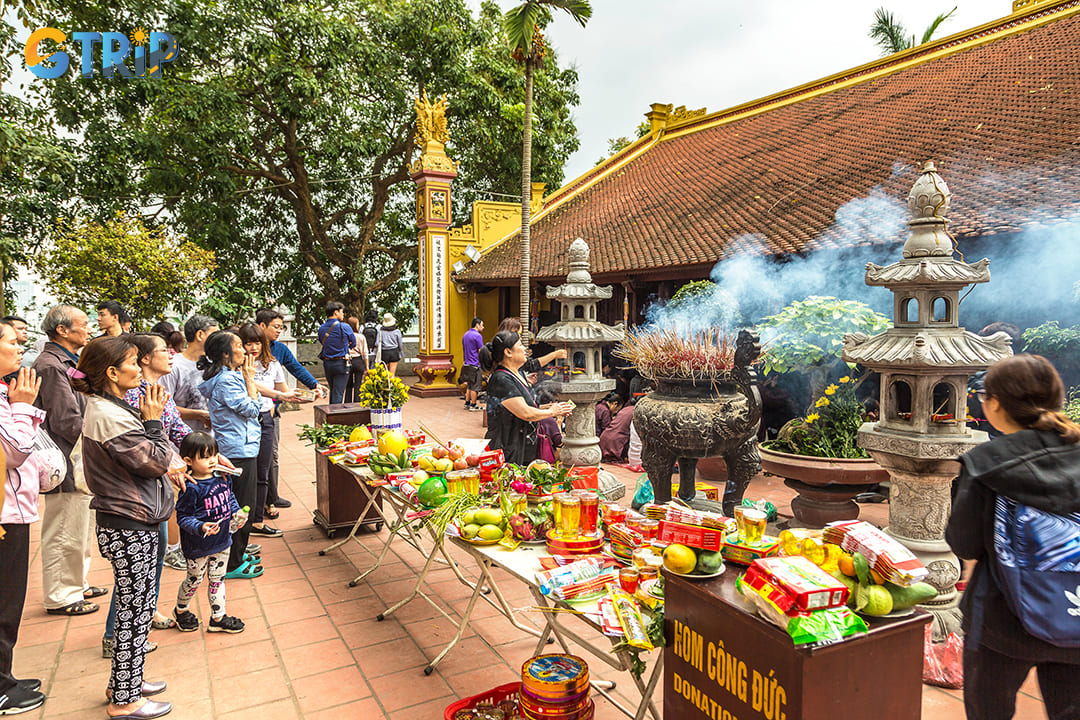
Tran Quoc Pagoda is a hub for various religious and cultural festivals
Spiritual practices and local devotion
Daily spiritual activities at Tran Quoc Pagoda offer a snapshot of the continuous devotion that underlines its importance. Regular prayer sessions take place, with both monks and lay tourists participating in chanting and meditation. These practices are vital for the meditation of inner peace and reflection, acting as a spiritual refuge for those seeking solace or wisdom.
The pagoda also plays a role in life cycle rituals, such as memorial services for deceased family members, which affirm its place in personal and communal spheres. This intersection of the sacred and the personal makes Tran Quoc a vital part of life in Hanoi, grounding spiritual experiences in everyday reality.
Locals frequently visit to make offerings of incense, flowers, and food, contributing to a vibrant and living religious tradition that continually breathes life into the temple grounds. These acts of devotion are testimonies of the pagoda’s deep-rooted religious significance in the lives of its practitioners.
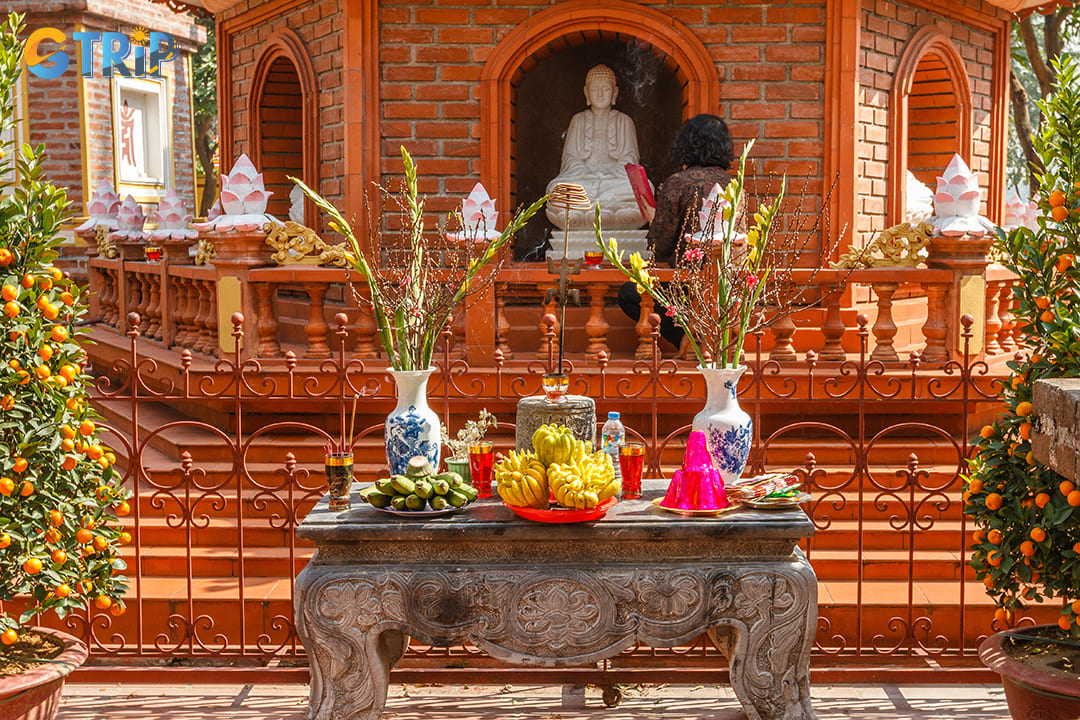
Locals frequently visit to make offerings of incense, flowers, and food
Practical visitor information
Here is some information that you should remember before visiting Tran Quoc Pagoda.
Opening hours and visitor guidelines
Tran Quoc Pagoda, situated on the serene West Lake in Hanoi, opens its doors to tourists daily, offering a unique glimpse into Vietnam's rich cultural tapestry. For those planning a visit, the pagoda typically welcomes guests from early morning until early evening. The opening hours are from 7:30 AM to 11:00 AM and 1:30 PM to 5:00 PM. These hours align with the Buddhist monks’ schedules, allowing both tourists and worshippers to enjoy the tranquil environment.
While visiting Tran Quoc Pagoda, it is essential to adhere to guidelines that respect the customs and spiritual practices observed at this revered site. You are expected to dress modestly; wearing clothing that covers shoulders and knees is advisable. This respects the religious nature of the site and aligns with the cultural expectations seen across various Buddhist temples.
Photography is permitted in most areas of the pagoda, yet it is recommended to be considerate and avoid taking photos during prayer times or of individual worshippers. This ensures that the sanctity and privacy of their religious practices are maintained. Additionally, while exploring the beautiful architecture and serene gardens, it is crucial to maintain a quiet and respectful demeanor, refraining from loud conversations.
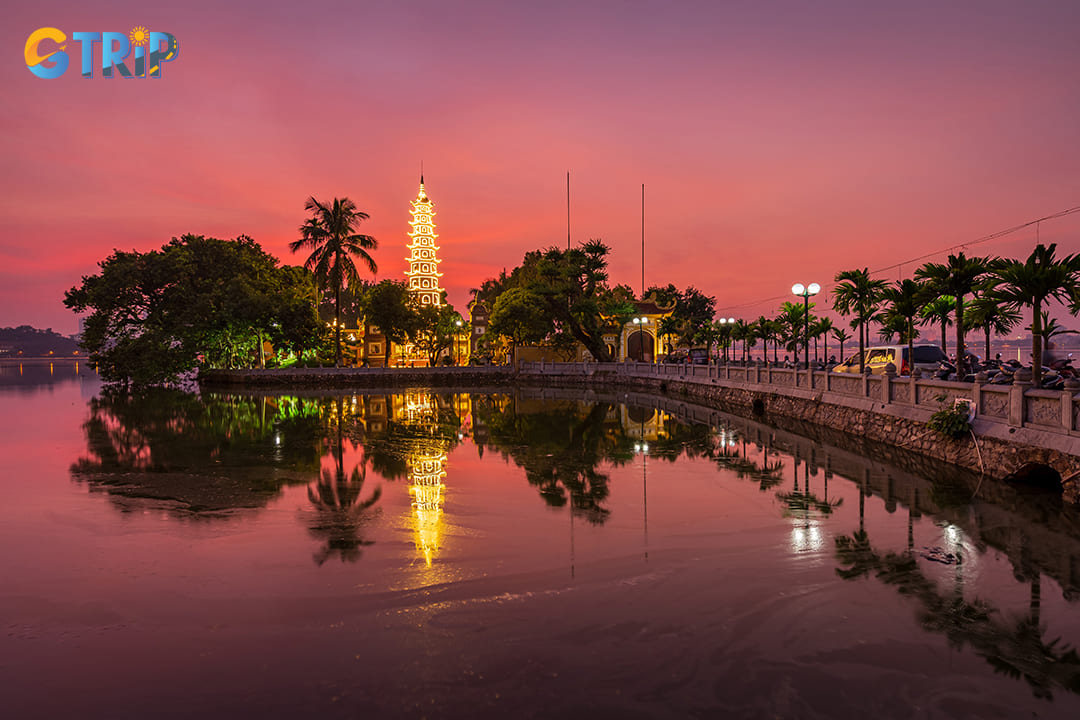
While visiting Tran Quoc Pagoda, it is essential to adhere to guidelines that respect the customs and spiritual practices observed at this revered site
Entrance fees and accessibility
Tran Quoc Pagoda is accessible to all people and maintains a welcoming approach by not charging an entrance fee. This aligns with the Buddhist values of openness and community. As such, individuals from all walks of life can experience its spiritual and architectural beauty without financial barriers.
However, donations are appreciated as they contribute to the maintenance and preservation of the site and are typically made voluntarily in donation boxes scattered throughout the temple grounds. These contributions assist in upholding the pagoda's operations and ongoing restoration efforts.
In terms of accessibility, Tran Quoc Pagoda is situated along Thanh Nien Road, a scenic location easily reachable by various modes of transportation such as taxis, motorbikes, or buses. For those with mobility challenges, certain areas of the pagoda, including steps and uneven pathways, may present difficulties. It is advisable for tourists requiring assistance or special accommodations to plan accordingly or seek assistance upon arrival.
Cultural etiquette for tourists
Understanding and respecting cultural etiquette is paramount when visiting Tran Quoc Pagoda. As with many religious sites, it is customary to remove one's shoes before entering specific temple buildings. This practice respects the sacrality of the space and also adheres to long-standing traditions observed in Buddhist culture. When engaging with monks or participating in any religious activities, it is appropriate to maintain a demeanor of respect and humility. You are encouraged to participate silently in rituals or ceremonies if you wish to observe the spiritual practices firsthand.
The pagoda also prompts tourists to be mindful of offerings and objects found within its walls. It is considered disrespectful to touch or move religious artifacts and offerings unless expressly permitted. Respecting these items is crucial as they hold significant spiritual and cultural value. Lastly, interactions with fellow tourists and local devotees can enhance the experience, maintaining decorum through polite gestures and language, and refraining from disruptive behavior.
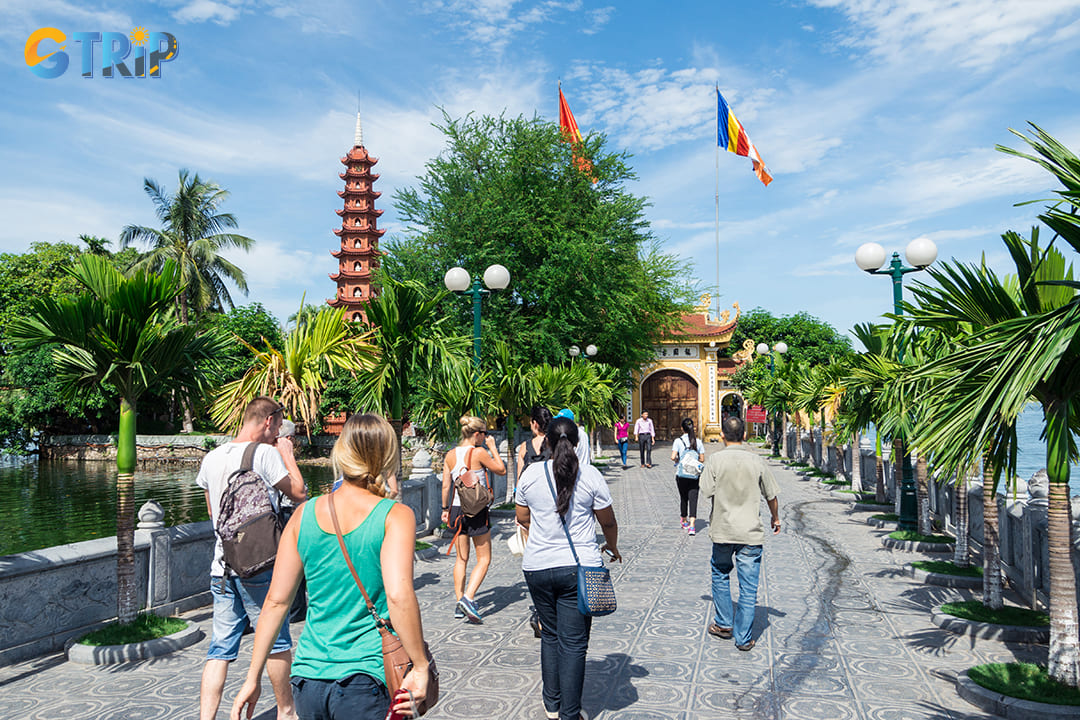
Understanding and respecting cultural etiquette is paramount when visiting Tran Quoc Pagoda
The best time to visit Tran Quoc Pagoda
You can consider many below elements to decide which time to visit the pagoda.
Seasonal weather conditions
Hanoi has a distinct tropical climate that can significantly affect the visiting experience at Tran Quoc Pagoda. It features four seasons: spring, summer, autumn, and winter, each offering a different atmosphere.
- Spring (March to April): This is arguably the best time to visit. The weather is mild and pleasant, with temperatures ranging from 18°C to 25°C (64°F to 77°F). Spring also marks the beginning of flowering, which complements the pagoda's aesthetic allure.
- Summer (May to August): Summers in Hanoi can be hot and humid, with temperatures often exceeding 30°C (86°F). While the lush greenery of West Lake is vibrant, the heat may be uncomfortable for some. It's crucial to prepare for sudden thunderstorms.
- Autumn (September to November): Autumn is another ideal time to visit. The weather cools down to a comfortable range of 20°C to 28°C (68°F to 82°F). The skies are generally clearer, providing excellent conditions for photography.
- Winter (December to February): Winters can be chilly, with temperatures dropping to 10°C to 15°C (50°F to 59°F). While the cold might deter some people, the serenity of the temple during this period is remarkable.
Recommended visiting times
The time of day also matters when planning a visit to Tran Quoc Pagoda:
- Morning: Early morning visits are recommended for those seeking a more contemplative experience. The soft morning light enhances the pagoda's architecture, and the area is generally quieter, allowing for easier exploration.
- Late afternoon: Visiting in the late afternoon provides a chance to witness a stunning sunset over West Lake. The golden hour offers captivating views and is perfect for photography enthusiasts.
- Avoid midday: To avoid crowds and inclement weather conditions, it is best to steer clear of midday visits, especially during the summer months.
Special events and festivals
Tran Quoc Pagoda, being a significant spiritual site, hosts a variety of events that might be of interest to cultural enthusiasts:
- Buddhist festivals: Key celebrations include Vesak (Buddha's birthday), an event of great importance where the temple bustles with activity. It usually takes place in April or May, following the lunar calendar.
- Lunar New Year (Tet): This festive period around late January to early February offers a unique cultural experience. The pagoda is adorned with traditional decorations, but it tends to be more crowded due to local celebrations.
Visiting Tran Quoc Pagoda requires thoughtful consideration of both the seasonal weather conditions and any special events or festivals. The best time is often in spring and autumn, with the added allure of participating in significant Buddhist ceremonies. Planning the visit at the right time ensures a memorable experience for every tourist.
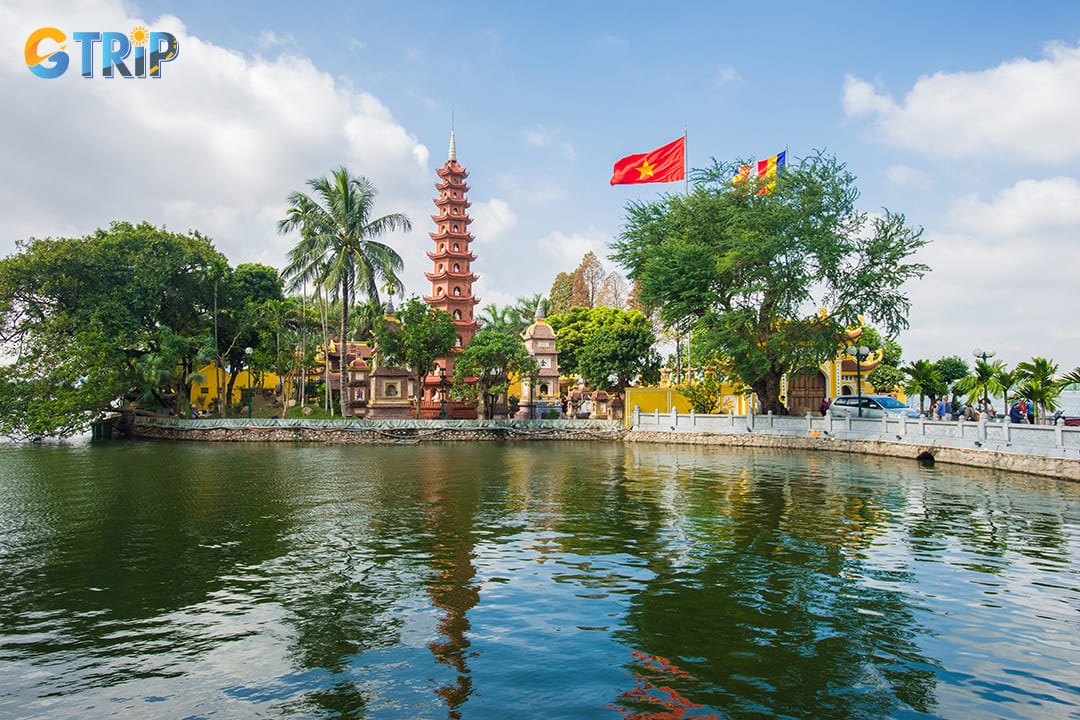
Visiting Tran Quoc Pagoda requires thoughtful consideration of both the seasonal weather conditions and any special events or festivals
Nearby attractions to explore from Tran Quoc Pagoda
Tran Quoc Pagoda offers a deep historical and cultural experience and also serves as a gateway to various nearby attractions that embody the vibrant essence of Hanoi. Exploring these places can enrich your visit and provide a broader understanding of Vietnam’s heritage and contemporary culture.
One Pillar Pagoda (2.2 km)
Located near the Ho Chi Minh Mausoleum, the One Pillar Pagoda is an architectural masterpiece dating back to the early 11th century. Built by Emperor Ly Thai Tong, the pagoda stands on a single stone pillar, designed to resemble a lotus flower rising from the water. This distinctive structure symbolizes purity and enlightenment in Buddhist philosophy, making it one of Vietnam’s most revered religious sites.
Beyond its architectural uniqueness, the One Pillar Pagoda holds deep cultural and spiritual significance. Over centuries, it has become a symbol of Hanoi, attracting visitors seeking both historical insights and moments of reflection. Despite its modest size, the pagoda’s design and serene surroundings create a tranquil retreat, offering a peaceful contrast to the city’s bustling streets.
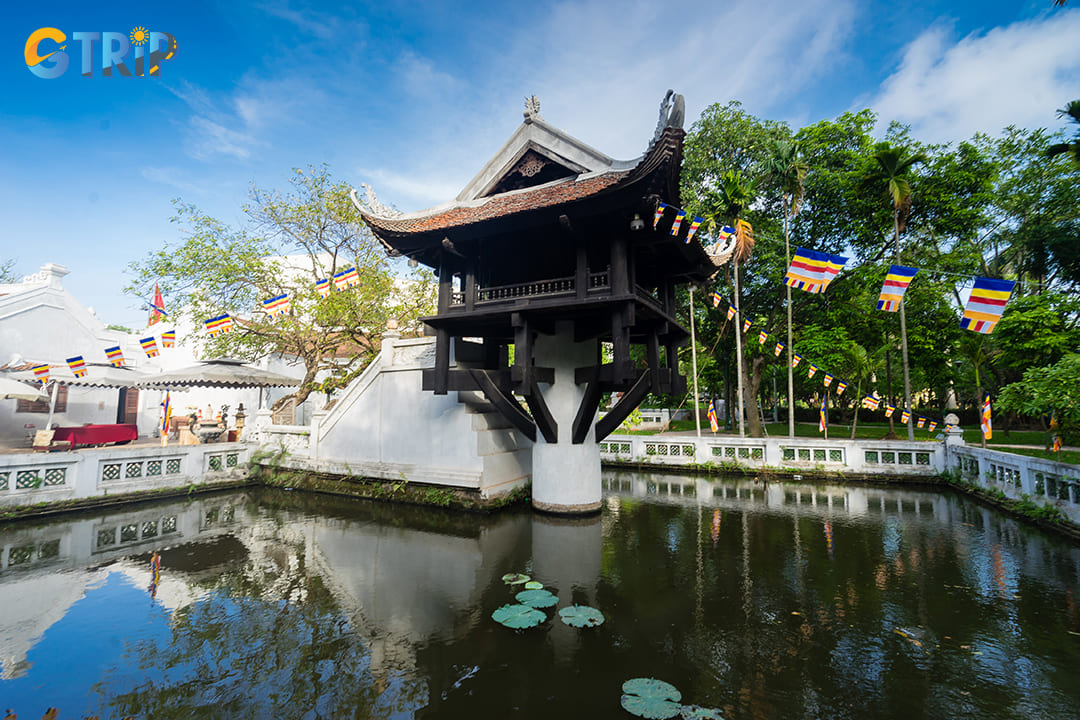
The pagoda stands on a single stone pillar, designed to resemble a lotus flower rising from the water
Quan Thanh Temple (1.3 km)
Quan Thanh Temple, an ancient Taoist sanctuary, has stood for nearly a thousand years as a tribute to Tran Vu, the Taoist deity of the North. Nestled near the shores of West Lake, this historic temple is renowned for its striking bronze statue of Tran Vu, intricate wood carvings, and serene courtyards shaded by ancient trees. Its timeworn gates and elaborate altars reflect the spiritual depth and artistic heritage of Vietnamese Taoism.
Stepping into Quan Thanh Temple offers a glimpse into Hanoi’s religious diversity and a chance to experience its tranquil atmosphere. The temple serves as a peaceful retreat from the city’s energetic rhythm, where you can appreciate centuries-old craftsmanship and witness traditional Taoist rituals. For those exploring Hanoi’s spiritual landmarks, Quan Thanh provides an enriching journey into Vietnam’s Taoist traditions.
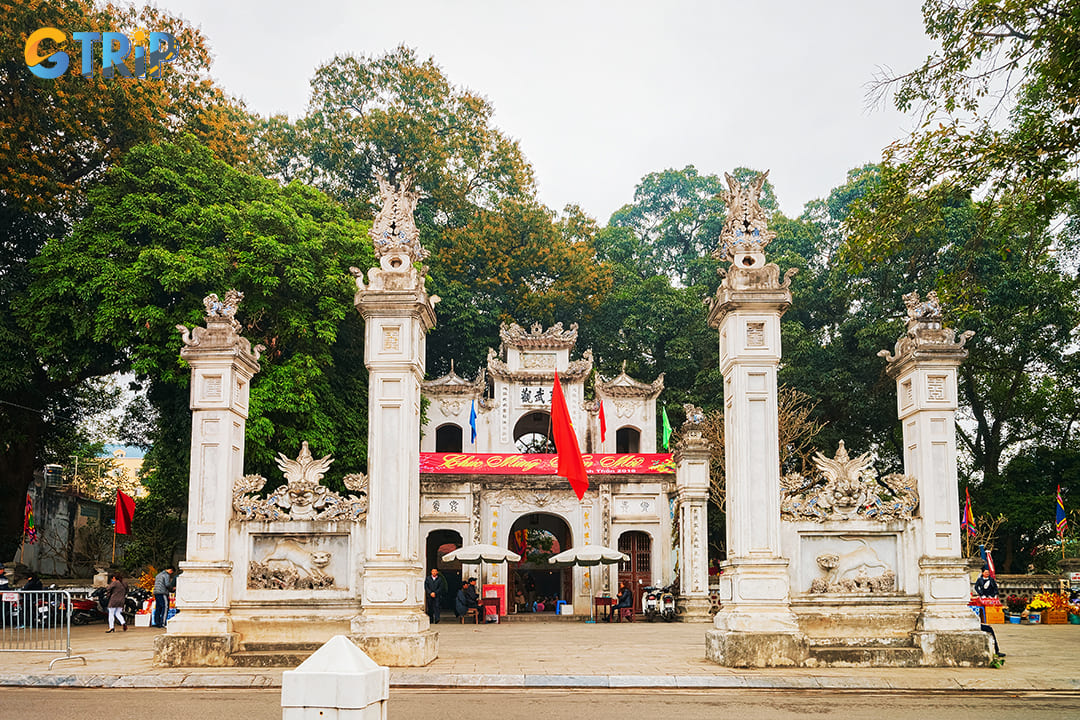
Stepping into Quan Thanh Temple offers a glimpse into Hanoi’s religious diversity and a chance to experience its tranquil atmosphere
Imperial Citadel of Thang Long (2.8 km)
The Imperial Citadel of Thang Long, a UNESCO World Heritage Site, stands as a testament to Hanoi’s rich and layered history. Once the political and military center of Vietnam for over a thousand years, the citadel preserves remnants from various dynasties. They include ancient gates, stone dragons, and underground bunkers used during the Vietnam War. Walking through its expansive grounds offers a tangible connection to the city’s past, from its royal beginnings to its strategic role in modern conflicts.
More than just a historical site, the citadel provides an immersive experience for those eager to understand Vietnam’s cultural evolution. Its architectural relics and archaeological discoveries reveal a story of resilience and transformation, making it a must-visit for history enthusiasts. The blend of imperial grandeur and wartime significance makes the Imperial Citadel of Thang Long a remarkable window into Hanoi’s enduring legacy.
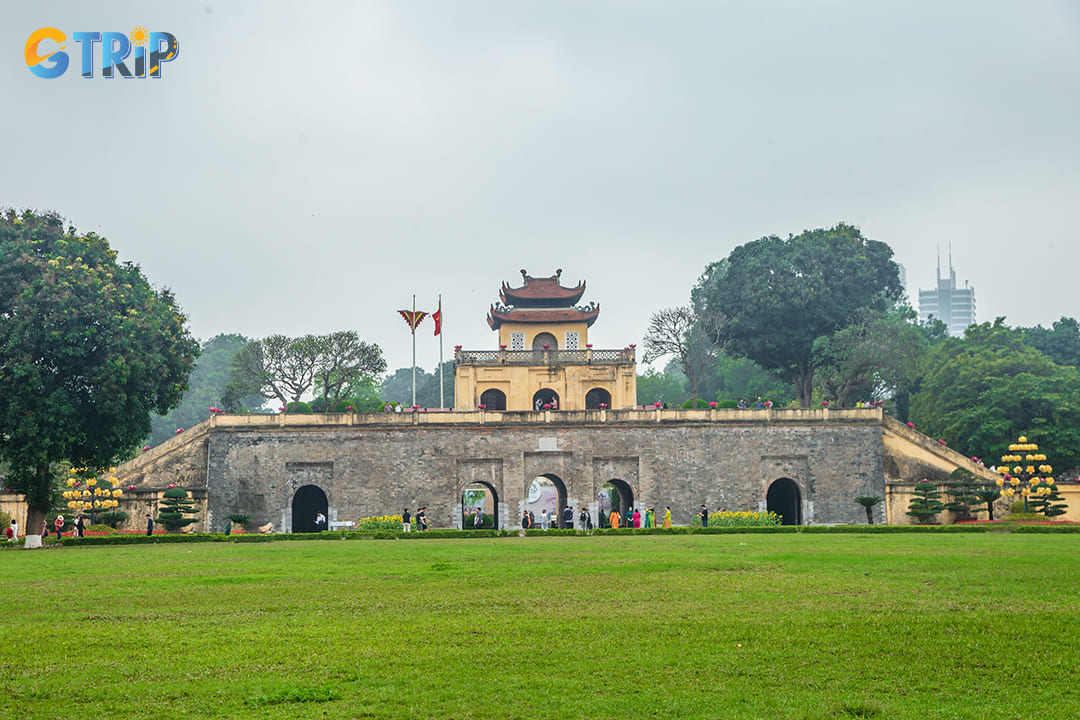
The Imperial Citadel of Thang Long stands as a testament to Hanoi’s rich and layered history
Local dining and shopping experiences
The area surrounding Tran Quoc Pagoda and West Lake is rich in culinary and shopping experiences that reflect the diverse culture of Hanoi.
- Street food and local cuisine: The Tay Ho District, enveloping West Lake, is renowned for its street food. From the famous Bun Cha (grilled pork served with noodles) to Pho Cuon (fresh spring rolls), the options are tantalizing and provide an authentic taste of Vietnamese cuisine.
- Traditional markets and boutiques: The bustling markets around West Lake offer everything from fresh produce to local handicrafts. Dong Xuan Market, albeit a short drive away, is one of the largest in Hanoi, providing a wide array of goods, from textiles to souvenirs.
- Modern boutiques and art galleries: In recent years, Tay Ho has become known for its burgeoning art scene, with numerous boutiques and galleries featuring contemporary Vietnamese art. This amalgam of tradition and modernity makes it a compelling area to explore for art enthusiasts.
Each of these nearby attractions complements the visit to Tran Quoc Pagoda, rounding out an exploration of Hanoi with a mix of cultural, historical, and recreational experiences. Together, they offer a cohesive narrative of the past and present, ensuring that visitors leave with a deep appreciation for the multifaceted charm of the city.
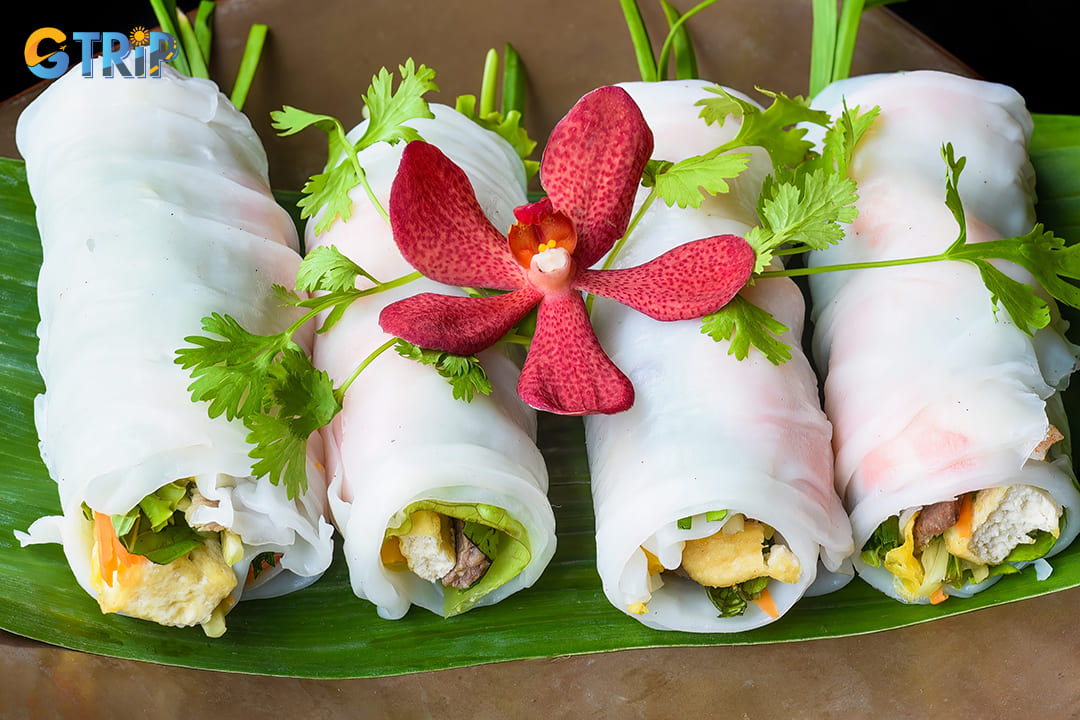
Pho Cuon provides an authentic taste of Vietnamese cuisine that you should try
Tran Quoc Pagoda is more than just a historic Buddhist site, it is a spiritual and architectural treasure that reflects Hanoi’s rich cultural heritage. With its centuries-old structures, serene lakeside setting, and deep-rooted significance, the pagoda offers you a peaceful retreat amidst the city's vibrant energy. By visiting Tran Quoc Pagoda, you gain cultural insight and also a moment of tranquility in the heart of the bustling capital. To make your journey even more enriching, consider planning your trip with GTrip - Vietnam Travel Agency, where expert guides can help you uncover the deeper stories behind Hanoi’s most iconic sites.

